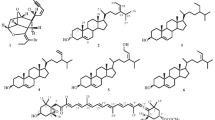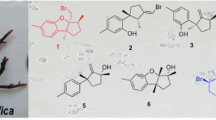Abstract
Extracts of Egyptian marine organisms from the Red Sea were screened for their anticancer activity using sulforhodamine B assay. The extract of the Red Sea sponge Spheciospongia vagabunda possessed promising anticancer activity against HepG2 (liver cancer cell line) and MCF-7 (breast cancer cell line). Isolation of three new ceramides: N-[(2S,3S,4R)-1,3,4-trihydroxytetradecan-2-yl] tridecanamide (1), (R)-2′-hydroxy-N-[(2S,3S,4R)-1,3,4-trihydroxypentacosan-2-yl] octadecanamide (2) and (R,Z)-2′-hydroxy-N-[(2S,3S,4R)-1,3,4-trihydroxytricosan-2-yl) nonadec-10-enamide (3) was accomplished via bioassay-guided fractionation. Structure elucidation was achieved using spectroscopic techniques, including 1D and 2D NMR and HRMS. Compounds 2 and 3 displayed high potential cytotoxicity against HepG2 (IC50 24.7 and 21.3 µM, respectively) and MCF-7 (IC50 26.8 and 29.8 µM, respectively), compared with doxorubicin as control drug.



Similar content being viewed by others
References
Ahmed SA, Khalifa SI, Hamann MT (2008) Antiepileptic ceramides from the Red Sea sponge Negombata corticata. J Nat Prod 71:513–515
Joseph B, Sujatha S (2011) Pharmacologically important natural products from marine sponges. Indian J Nat Prod 4:5–12
Kuksis A (1978) Hand book of lipid research fatty acids and glycerides; separation and determination of structure of fatty acids, vol 1. Springer, New York, pp 1–76
Lemieux RU, Von Rudlo E (1955) Periodate-permanganate oxidations I. Oxidation of olefins. Can J Chem 33:1701–1709
Ma W, Xiao D, Deng S (2004) Studies on chemical constituents of marine sponge Spheciospongia vagabunda from the South China Sea. Chin J Mar Drugs 23:15–17
Meyer M, Guyot M (2002) New Spingosines from the marine sponge Grayella cyatophora. J Nat Prod 65:1722–1723
Pettit GR, Xu J-P, Chapuis JC, Pettit RK, Tackett LP, Doubek DL, Hooper JNA, Schmidt JM (2004) Antineoplastic agents. 520. Isolation and structure of irciniastatins A and B from the Indo-Pacific marine sponge Ircinia ramosa. J Med Chem 47:1149–1152
Rui-Dong D (2005) Anticancer compounds and sphingolipid metabolism in the colon. In Vivo 19:293–300
Safaeian S, Hosseini H, Abbas Pour Asadolah A, Farmohamadi S (2009) Antimicrobial activity of marine sponge extracts of offshore zone from Nay Band Bay Iran. J Mycol Med 19:11–16
Salma Y, Lafont E, Therville N, Carpentier S, Bonnafe M-J, Levade T, Génisson Y, Andrieu-Abadie N (2009) The natural marine anhydrophytosphingosine, Jaspine B, induces apoptosis in melanoma cells by interfering with ceramide metabolism. Biochem Pharm 78:477–510
Salomon CE, Magarvey NA, Sherman DH (2004) Merging the potential of microbial genetics with biological and chemical diversity: an even brighter future for marine natural products drug discovery. Nat Prod Rep 21:105–121
Sipkema D, Franssen M, Osinga R, Tramper J, Wijffels R (2005) Marine sponge as pharmacy. Mar Biotechnol 7:142–162
Skehan P, Storeng R, Scudiero D, Monks A, Mcmahon J, Vistica D, Warren JT, Bokesch H, Kenney S, Boyd MR (1990) New colorimetric cytotoxicity assay for anticancer-drug screening. J Nat Cancer Inst 82:1107–1112
Sun Y, Xu Y, Liu K, Hua H, Zhu H, Pei Y (2006) Gracilarioside and gracilamides from the Red Alga Gracilaria asiatica. J Nat Prod 69:1488–1491
Tan RX, Chen JH (2003) The cerebrosides. Nat Prod Rep 20:509–534
Whitson E, Bugni TS, Chockalingam PS, Concepcion GP, Harper MK, He M, Hooper JNA, Mangalindan GC, Ritacco F, Ireland CM (2008) Spheciosterol sulfates, PKCζ inhibitors from a philippine sponge Spheciospongia sp. J Nat Prod 71:1213–1217
Acknowledgments
The authors are grateful to R.W.M. van Soest, Faculty of Science, Zoological Museum Amsterdam, for taxonomic identification of the sponge samples. Thanks are also due to the Egyptian Environmental Affairs Agency (EEAA) for facilitating sample collection along the coasts of the Red Sea.
Author information
Authors and Affiliations
Corresponding author
Ethics declarations
Conflict of interest
The authors declare no conflict of interest.
Electronic supplementary material
Below is the link to the electronic supplementary material.
Rights and permissions
About this article
Cite this article
Eltamany, E.E., Ibrahim, A.K., Radwan, M.M. et al. Cytotoxic ceramides from the Red Sea sponge Spheciospongia vagabunda . Med Chem Res 24, 3467–3473 (2015). https://doi.org/10.1007/s00044-015-1394-9
Received:
Accepted:
Published:
Issue Date:
DOI: https://doi.org/10.1007/s00044-015-1394-9




